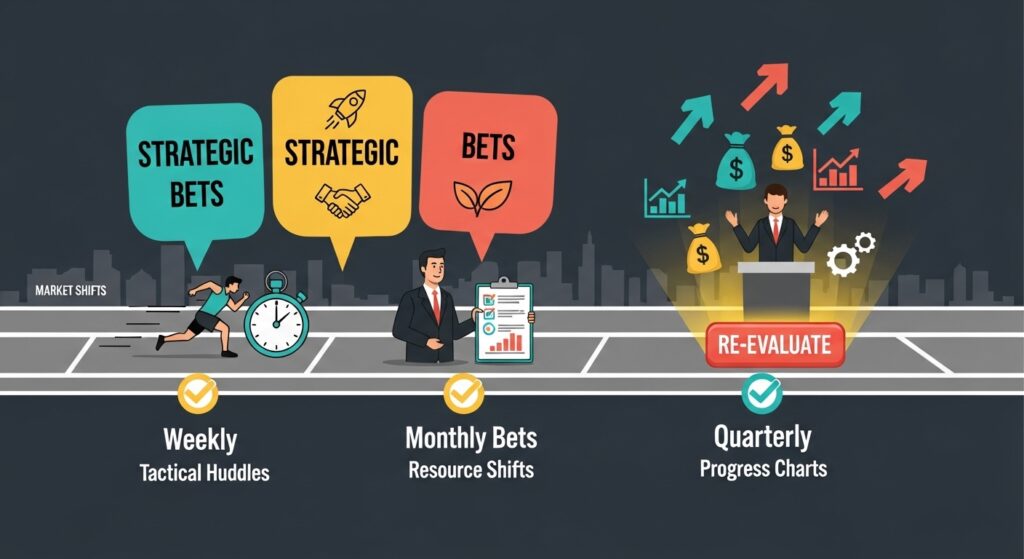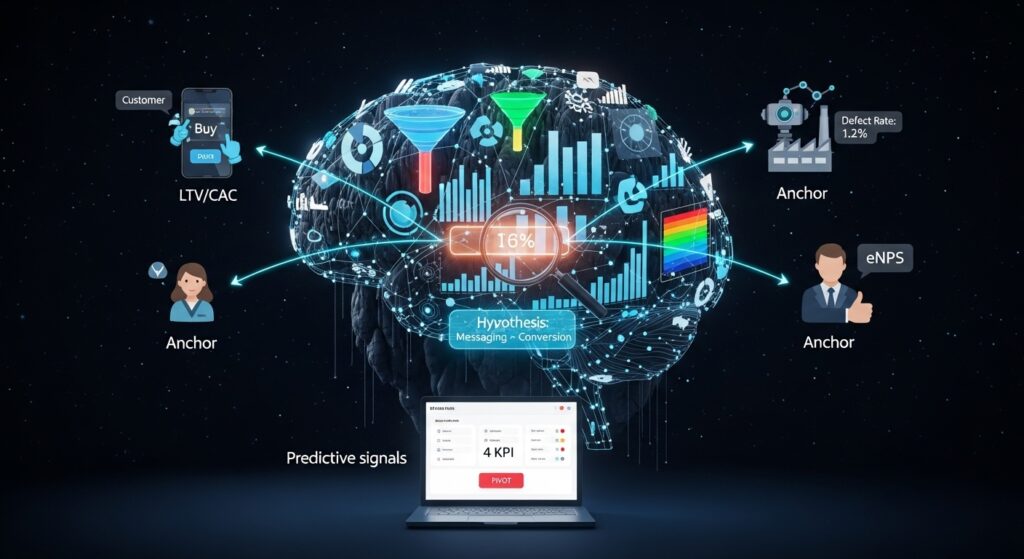Master leadership. Build adaptive strategies. Make data work for decisions.
In this guide you’ll get a practical, evidence-backed roadmap based on the themes in Pedro Paulo’s work — leadership development, data-driven strategy, and organizational transformation — plus unique, actionable tactics you can use this week.
Why Pedro Paulo’s approach matters now
Organizations face faster market shifts, tighter talent markets, and higher expectations for measurable impact from leadership programs. Pedro Paulo’s focus — integrating leadership development with strategy and data — is tuned to that reality: leaders must align purpose (vision), execution (strategy), and evidence (data) to produce sustainable advantage.
This isn’t just theory. Research consistently shows that companies that embed analytics into decision-making and invest sensibly in leadership produce better outcomes: highly data-driven organizations report materially better decision quality and business performance.
Short takeaway: strategy without data is guesswork. Leadership without alignment is friction. Pedro Paulo’s framework ties those threads into an operational model.
Core philosophy: Vision + Data + People

Pedro Paulo’s method can be condensed into three interlocking pillars:
- Vision & Alignment — Strategy must start from a clear mission and translate to specific objectives.
- Data & Analysis — Use targeted analytics to reduce uncertainty and validate assumptions.
- Leadership & Culture — Develop decision capability across the organization so strategy executes reliably.
Each pillar answers a question:
- Vision: Where are we going?
- Data: How do we know we’ll get there?
- People: Who will lead and execute the journey?
This triad prevents the common pitfalls of fuzzy goals, overcomplex plans, and poor execution.
Strategy development — a practical playbook
Below is a working playbook you can use to develop or refresh strategy — no fluff, only the parts that drive decisions.

1. Clarify purpose and outcomes (Alignment)
- Restate (or craft) a one-sentence vision. Example: “Become the preferred sustainable supplier in our region by 2028.”
- Translate vision into 3–5 strategic priorities (e.g., customer retention, product differentiation, operational excellence).
- Map each priority to a measurable outcome and owner.
Why this works: clarity reduces debate and speeds execution.
2. Use complementary analysis tools, purposefully
- SWOT for internal/external scan (strengths/weaknesses → internal; opportunities/threats → external). Use it to surface hypotheses to test.
- PESTEL for macro drivers (policy, economy, tech, environment, regulation) when expanding or entering new markets.
- Porter’s Five Forces to validate industry attractiveness and competitive positioning. Use it when assessing long-term profitability or new market entry.)
Actionable tip: Don’t run every framework every quarter. Use them based on the strategic question (e.g., Five Forces for industry strategy; PESTEL for market entry).
3. Define clear strategic bets (not a laundry list)
- Convert priorities into 3–7 strategic bets — focused, resourced experiments you commit to execute for 6–18 months.
- For each bet define: objective, leading & lagging metrics, owner, expected impact, and downside risk.
4. Build a decision cadence (governance)
- Weekly tactical huddles (operations)
- Monthly strategy reviews (progress on strategic bets, resource shifts)
- Quarterly re-evaluation (validate assumptions, reallocate capital)
Why cadence matters: it transforms strategy from a document into a living process — enabling quick pivots.
Leadership development that actually moves the needle

Leadership development is too often treated as a checkbox workshop. Pedro Paulo emphasizes sustained, measurable development across three dimensions: capability, decision-making, and culture.
Core competencies to build
- Emotional intelligence — self-awareness and relationship management (improves team outcomes).
- Communication and storytelling — make strategy understandable and motivating.
- Financial acumen — leaders need to translate strategy into P&L and cash-flow realities.
Harvard Business research shows organizations must expand leadership behaviors to meet evolving challenges — one-off training is insufficient. The most effective programs combine assessment, stretch assignments, and coaching.
Practical development mechanisms
- Leadership sprints: 8–12 week cycles mixing coaching, applied projects, and peer learning.
- Mentorship pairings: experienced ↔ emerging leaders for 6–12 months with measurable objectives.
- Decision rehearsals: run simulated strategic decisions (scenario planning + role-play).
- Financial literacy modules: short, practical workshops tied to real company metrics.
Measuring leadership ROI
- Track leading indicators (e.g., speed to decision, cross-functional collaboration scores) and lagging indicators (employee engagement, retention, improvements in KPI outcomes). Studies indicate leadership development can deliver significant ROI when tied to business metrics.
Data-driven decision making: frameworks and KPIs to track

Data is the backbone of modern strategy. But “more data” is not the goal — better signals are.
Which metrics matter (core KPIs)
- Revenue growth (headline impact).
- Customer acquisition cost (CAC) and lifetime value (LTV) (marketing efficiency).
- Employee engagement / eNPS (organizational health).
- Operational KPIs tied to strategic bets (e.g., on-time delivery, defect rate).
Set a balanced mix of financial, customer, and people KPIs. Dashboards should show leading indicators to enable early course correction.
Frameworks to apply data sensibly
- Hypothesis-driven analytics: turn strategic questions into testable hypotheses (A/B tests, cohort analysis).
- Cohort & funnel analysis: to understand where customers drop off and which interventions move the needle.
- Predictive signals: use simple models to forecast risk (e.g., churn propensity) — you don’t need full ML to get value.
- Experimentation cadence: commit to rapid, small experiments with clear success criteria.
McKinsey and other firms document the measurable advantage of data-led organizations — higher productivity, faster decision cycles, and better profitability. Use data to reduce uncertainty around your strategic bets, not to justify every meeting.
Tools & lightweight tech stack
- BI / dashboarding: Looker, Tableau, Power BI (or low-cost alternatives for SMBs).
- Data warehouse: centralize sources for consistent definitions.
- Lightweight experimentation platforms (even Google Optimize or feature-flagging tooling).
- Routine: weekly KPI review with a short insight + recommended action.
Resource allocation & execution: prioritize for impact
Most strategies fail at resource commitment. Execution requires ruthless prioritization.
Prioritization framework (three lenses)
- Impact: expected contribution to strategic outcomes
- Feasibility: skills, time, capital required
- Risk / Dependency: single points of failure or required prerequisites
Score initiatives across these axes and allocate resources to the highest-scoring bets. Revisit allocations monthly.
Flexible reallocation
- Keep 10–20% of strategic resources uncommitted as a flexibility buffer to respond to new evidence (market shifts, competitor moves, or validated experiments).
Monitoring & governance
- Create a one-page project brief for each strategic bet: objective, owner, metrics, timeline, budget.
- Use a lightweight RACI (Responsible / Accountable / Consulted / Informed) to prevent decision paralysis.
Measure, review, iterate: the continuous-improvement loop

No strategy is final. The best organizations treat strategy as an iterative process.
The loop: Plan → Do → Check → Adapt
- Plan: set hypothesis and metrics for each strategic bet.
- Do: run the initiative with disciplined execution.
- Check: measure against leading metrics and customer feedback.
- Adapt: pivot, double-down, or kill initiatives based on evidence.
Regular feedback loops (employee and customer) are essential — they surface reality that dashboards sometimes miss.
Feedback culture & recognition
- Build short feedback cycles (surveys, customer interviews, frontline debriefs).
- Recognize teams that responsibly stop initiatives that don’t work — killing bad projects quickly is as valuable as launching winners.
Research links strong recognition and engagement programs with higher productivity and lower turnover — something leadership programs should explicitly track.
Case examples & real-world signals of success
Below are two concise examples (drawn from the earlier brief) that illustrate the kinds of outcomes possible when strategy + data + leadership align.
Case A — Customer-led marketing optimization
- Challenge: Marketing spend yielded low conversions.
- Approach: Use customer segmentation and campaign A/B tests to match messaging to highest-value cohorts.
- Result: 30% increase in sales for targeted cohorts (Company A). (Example provided in source brief.)
Case B — Market analysis leads to product expansion
- Challenge: Stagnant product pipeline.
- Approach: Market analysis identified an underserved segment; cross-functional team launched a focused MVP.
- Result: Successful product launch and new revenue stream for Company B. (Example provided in source brief.)
These case summaries are intentionally short — treat them as templates you can adapt: identify the hypothesis, pick metrics, execute, and report.
How to start — a 30/60/90-day plan inspired by Pedro Paulo
Day 0: Convene leadership for a 2-hour alignment session. Agree vision and 3 priorities.
0–30 days: Diagnose & align
- Run a rapid SWOT + one focused customer or market scan. (Use a short survey or 5–10 customer interviews.)
- Identify 2 strategic bets to pursue in the next quarter.
- Baseline KPIs and build a simple dashboard.
31–60 days: Pilot & develop leaders
- Launch first experiments (marketing, product tweak, operational sprint).
- Start leadership sprints for priority leaders (coaching + applied project).
- Set up weekly huddles and monthly strategic review.
61–90 days: Evaluate & scale
- Review data and customer feedback. Kill or scale experiments based on evidence.
- Reallocate budget to the highest-performing bets.
- Report to broader org with clear metrics and next steps.
This phased plan balances exploration with execution — you build clarity, test assumptions, and scale what works.
Conclusion: lead with vision, decide with data, deliver with people
Pedro Paulo’s approach is practical: clarify your mission, design a few concentrated strategic bets, instrument those bets with the right metrics, and develop leaders who can decide and execute under uncertainty.
Remember:
- Clarity (vision and alignment) reduces wasted effort.
- Evidence (data and KPIs) reduces risk.
- Capability (leadership and culture) ensures the plan becomes reality.
Commit to short cycles, measure what matters, and treat leadership development as a continuous business lever — not an HR checkbox. That’s how strategy becomes sustained advantage.
Selected quotes & supporting sources
“The data-driven enterprise of 2025 shows organizations that embrace analytics change how they operate and make decisions.” — McKinsey.
“Leadership development must move beyond episodic training to be embedded in business transformation.” — Harvard Business Publishing’s Global Leadership Development studies.
“SWOT, Porter’s Five Forces, and SMART goals remain practical frameworks — but the value comes from how leaders use them to test assumptions and make decisions.” — Investopedia / HBS resources.
Practical templates you can copy (quick)
One-sentence vision + 3 priorities (template)
- Vision: [One crisp sentence about the future state]
- Priority 1: [What we must do to achieve the vision] — Owner: [Name] — Metric: [KPI]
- Priority 2: [Another focus] — Owner — Metric
- Priority 3: [Another focus] — Owner — Metric
Strategic bet brief (one page)
- Title
- Objective (SMART)
- Owner(s)
- Leading metric(s)
- Lagging metric(s)
- Timeline (6–18 months)
- Budget
- Major risks & dependencies
- Exit criteria (when to pivot/kill)
FAQs Pedro Paulo’s Approach
Q1: What makes Pedro Paulo’s consulting approach different?
A: The integration of leadership development, focused strategic bets, and data-driven validation — each element is designed to reinforce the others so strategy is executable, measurable, and adaptive.
Q2: How can data improve leadership decisions?
A: Data provides objective signals (customer behavior, financials, operational performance) that reduce uncertainty, enable testing of hypotheses, and speed up feedback cycles — critical for better decisions. See McKinsey and HBS summaries for evidence.
Q3: How do I measure the ROI of leadership programs?
A: Tie leader development to business outcomes (revenue impact, retention, speed of decision-making) and track both leading indicators (behavior change) and lagging indicators (financial performance, engagement). Several studies find material ROI when programs are aligned with business goals.
Q4: How often should we revisit strategy?
A: Maintain a monthly-to-quarterly cadence: monthly reviews for progress and adjustments; quarterly for re-evaluating bets and resource allocations.
Q5: What’s the simplest way to start if resources are tiny?
A: Pick one high-impact bet, define a single leading metric, run a small experiment, and start a weekly data review. Pair that with one leadership sprint (a cross-functional, project-based learning cycle).
Sources & further reading
- McKinsey — The data-driven enterprise of 2025.
- Harvard Business Publishing — 2024 Global Leadership Development Study.
- HBR — The Future of Leadership Development.
- Investopedia — SWOT Analysis.
- HBS Institute for Strategy and Competitiveness — The Five Forces.
- TechTarget/SMART goals definitions and best practices.



